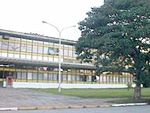Monument to Ramos de Azevedo

The Monument to Ramos de Azevedo is a sculptural set in bronze and granite located in the city of São Paulo. It was designed by Italian-born Brazilian sculptor Galileo Emendabili as a posthumous tribute to Francisco de Paula Ramos de Azevedo, one of the most prominent names in architecture and urbanism in São Paulo. Azevedo died on 12 June 1928 and the monument in his honor, chosen through a competition, was inaugurated on 25 January 1934, the city's anniversary. Originally located on Tiradentes Avenue, in front of the Pinacoteca do Estado building - an important work by Azevedo himself - it was dismantled in 1967, due to the construction of São Paulo's metro, and then transferred to the Cidade Universitária Armando de Salles Oliveira in 1973, where it remains until today, in the square that bears Azevedo's name, next to the Polytechnic School, an institution he helped to create. Construction of the monument began in 1929 and was finished six years later.
Excerpt from the Wikipedia article Monument to Ramos de Azevedo (License: CC BY-SA 3.0, Authors, Images).Monument to Ramos de Azevedo
Praça Ramos de Azevedo, São Paulo Butantã (Butantã)
Geographical coordinates (GPS) Address External links Nearby Places Show on map
Geographical coordinates (GPS)
| Latitude | Longitude |
|---|---|
| N -23.556944444444 ° | E -46.734166666667 ° |
Address
Monumento a Ramos de Azevedo
Praça Ramos de Azevedo
05508-901 São Paulo, Butantã (Butantã)
São Paulo, Brazil
Open on Google Maps










